Some Personal Perspectives on the History of Fort Casimir and New Amstel
 CLICK ON PARTS OF THE IMAGE TO SEE THEM FULL SIZE -- From top left:
CLICK ON PARTS OF THE IMAGE TO SEE THEM FULL SIZE -- From top left: Mar. 3 1656 authorization creating New Amstel from Ft. Casimir. Amsterdam City Archives
Former Dutch West India House, Amsterdam,
Saskatchewan river crossing north of Banff, Canada. A Hudson's Bay Company trading route.
Hudson's Bay Company trading posts. 500 employees in half of Canada.
Vest with bullet hole worn by Henry Casimir. Rijksmuseum, Amsterdam
View from "El Morro" fort above San Juan PR, which West India Company soldiers besieged and burned.
Slightly incorrect statement given by the municipality of Nieuwer Amstel in 1951 on the occasion of the 300th anniversary of New Castle's founding. In New Castle City Hall.
Fortress like facades of the City Archives of Amsterdam, source of many of the documents on these pages.
"Welcome to Curacao" at the island's cruise terminal. Peter Stuyvesant ruled it along with Aruba and Bonaire for the WIC. Nearby is St. Maartin where he lost his leg trying to recapture the island from the Spanish for the WIC.
There are many histories and descriptions available of Ft. Casimir and New Castle (see Resources including Vincent (1870), Scharf (1888), Cooper (1905), WPA (1938) Hart (1965), and Jacobs (2015). I've known general outlines and many details about Ft. Casimir and New Amstel for some time. They all tell portions of the same story:
* 1609 Hudson discovers the Delaware River
* The Dutch West India Company (WIC) comes to North America, founds New Amsterdam (New York) in 1625 and builds many forts including some on the Delaware.
* 1638 Swedes found Ft. Christina near modern Wilmington.
* 1651 Stuyvesant founds Ft. Casimir on the South (Delaware) River.
* 1655/1656 Swedes capture Ft. Casimir/Stuyvesant recaptures it, names it New Amstel
* 1664-1674 English capture New Amstel & New Netherland; Dutch recapture them; English recapture them.
This simple story is not satisfying because it does not answer the many questions of "Why...?"
Why did the WIC come to America?
What kind of a trading company was the WIC -- a friendly company like Macys?
What were the business models of the WIC and organizations from other countries?
What was Stuyvesant like?
Who was THE Mr. Casimir?
Why do we speak English and not Dutch; Did the Dutch get anything out of the whole colonization thing?
A number of good books provide most of the answers to these questions, I heartily recommend:
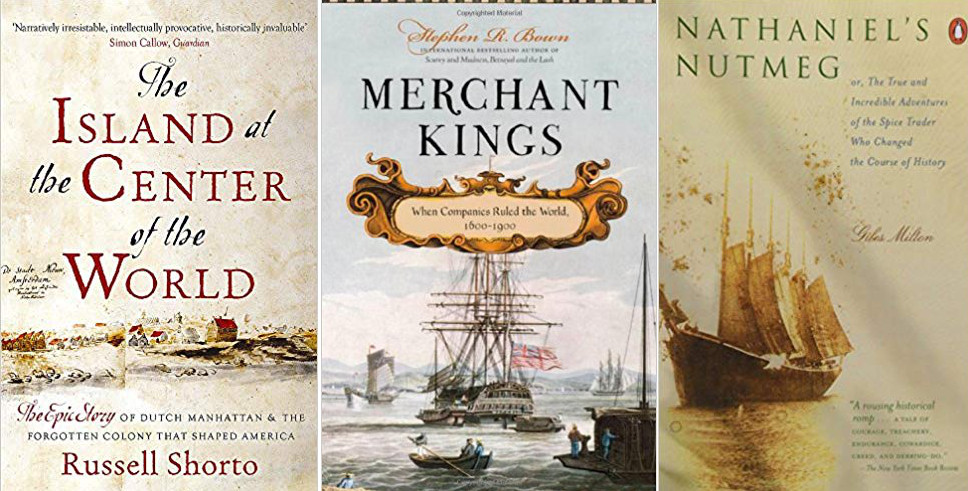
Island at the Center of the World (Russel Shorto) -- Hudson, WIC, New Amsterdam, Stuyvesant... But not much about New Castle. Available in Delaware libraries both in print and audio form. Great to listen to in the car!
Merchant Kngs: When Companies Ruled the World, 1600-1900. (Stephen Bown) -- Chapters on the Dutch EAST India Company, Stuyvesant and the WIC, and the Hudson's Bay Company. Perspective on the way people given power to rule a colony behave so unlike the behavior of the countrymen at home.
Nathaniel's Nutmeg: Or the True and Incredible Adventures of the Spice Trader Who Changed the Course of History (Giles Milton) -- Details on the Spice Race -- the race for the incredibly lucrative spice trade between the English and Dutch, and why at the end of the Anglo Dutch wars, England chose to take New Netherland including New York, despite it's relatively puny trade income, and the Dutch chose the East Indies with their fabled spices.
I've found that as I travel on vacation, I often see things that give me new perspectives on these "why" questions, both literally and figuratively. Like looking down at a town in Puerto Rico the WIC burned, looking up at a fort in St. Martin where Stuyvesant lost his leg, looking at house in Amsterdam that resembles one that once stood on The Strand in New Castle near my house, looking at garments with bullet holes of two men who might have been THE Mr. Casimir, looking at an image of the City Council meeting resolution in 1656 authorizing the purchase of land for New Amstel and realizing it's totally unreadable to me except a few dates and placenames.
Was the West India Company (WIC) a trading company, a military organization, or both?
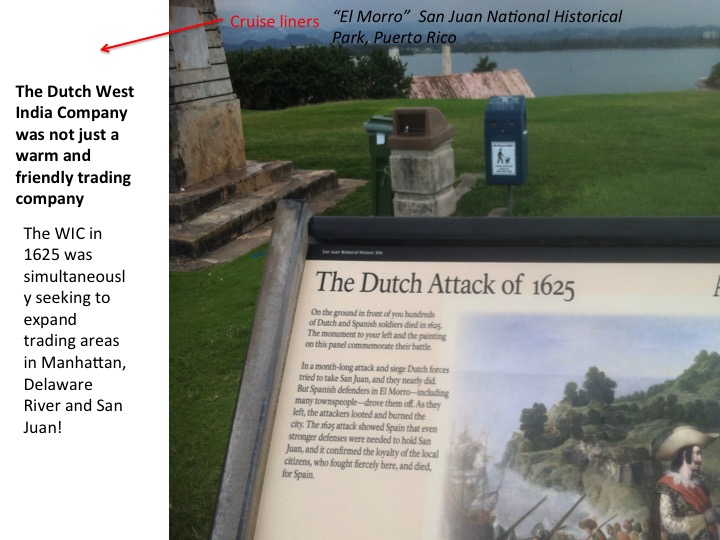 My wife and I went on a cruise starting in San Juan, Puerto Rico. We visited the huge El Morro fort,
a National Park System site. Looking down on the town
where the Dutch West india Company soldiers attacked the fort made me think about what kind of a company the Dutch West India Company (WIC) was. The sign said "The Dutch Attack of 1625.
On the ground in front of you hundreds of Dutch and Spanish
soldiers died... In a month-long attack and siege, Dutch forces tried to take San Juan, and they nearly did...As they left, the attackers looted and burned the city."
That was in 1625, the same year the WIC bought Manhattan for "$25" in trinkets. The WIC captured St. Maarten/St. Martin in 1634 with 6 ships and 225 men.
My wife and I went on a cruise starting in San Juan, Puerto Rico. We visited the huge El Morro fort,
a National Park System site. Looking down on the town
where the Dutch West india Company soldiers attacked the fort made me think about what kind of a company the Dutch West India Company (WIC) was. The sign said "The Dutch Attack of 1625.
On the ground in front of you hundreds of Dutch and Spanish
soldiers died... In a month-long attack and siege, Dutch forces tried to take San Juan, and they nearly did...As they left, the attackers looted and burned the city."
That was in 1625, the same year the WIC bought Manhattan for "$25" in trinkets. The WIC captured St. Maarten/St. Martin in 1634 with 6 ships and 225 men.
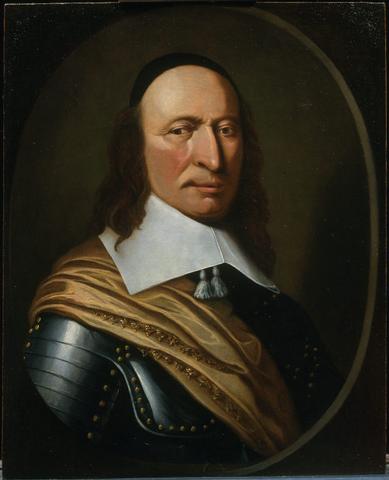 It was later captured by the Spanish. Stuyvesant
lost his leg to a cannon ball in 1644 when trying to retake the island with 12 ships and 1,000 men.
The WIC was a trading company with a government granted monopoly, but a military orientation towards its operations and subjects. Stuyvesant said
"We derive our authority from God and the West India Company, not from the pleasure of a few ignorant subjects."
It was later captured by the Spanish. Stuyvesant
lost his leg to a cannon ball in 1644 when trying to retake the island with 12 ships and 1,000 men.
The WIC was a trading company with a government granted monopoly, but a military orientation towards its operations and subjects. Stuyvesant said
"We derive our authority from God and the West India Company, not from the pleasure of a few ignorant subjects."
The Rise and Fall of the Dutch West India Company
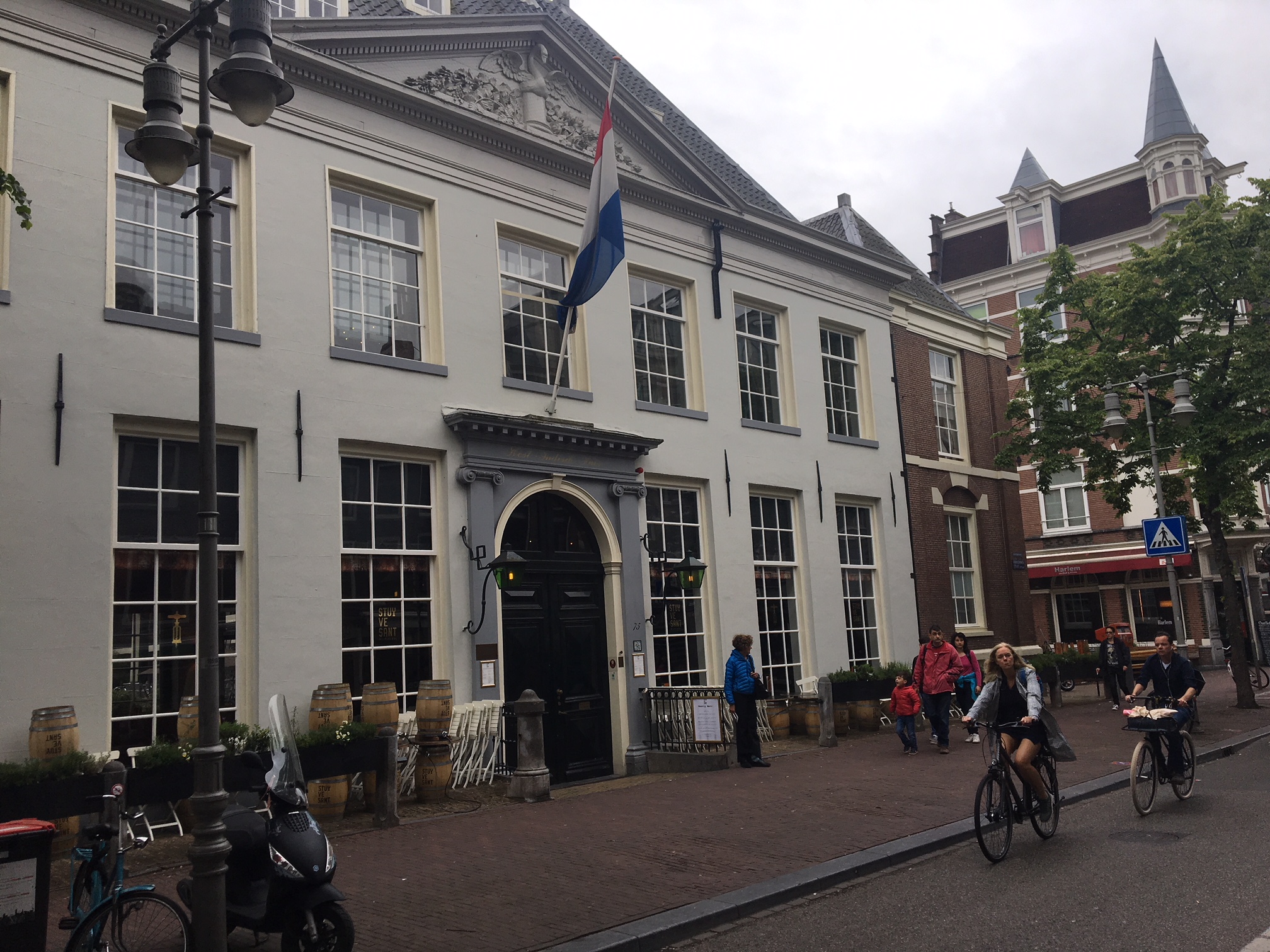 We went on a wonderful trip to celebrate my 75th birthday to Barcelona, London, Paris and Amsterdam. On the way to see other sights, we saw
the West India House off Brouwersgracht canal (my wife Rita is to the right of the door, trying to stay warm on May 16, 2017). It was built in 1617 (400 years earlier) and rented to the WIC
from 1623, unil 1647 when the company went bankrupt the first time. Stuyvesant would have come here after his
leg was shot off in 1644 until he was named "Director General of New Netherland, Curacao, Bonaire, Aruba and their dependencies" in 1645.
The company was then in deep financial difficulties due to the loss of its Brazilian
colonies and the expense of the war thereof. Initially the company's goals were land conquest and privateering. A major success in that area was the capture of the 16 ships in the
Spanish "Silver fleet". The company was in financial difficulties in 1656 when Stuyvesant retook Ft. Casimir, and that contributed to selling it the Amsterdam.
After the second bankruptcy in 1674, a new company was formed, mostly funded by the financially lucrative slave trade in the Caribbean.
We went on a wonderful trip to celebrate my 75th birthday to Barcelona, London, Paris and Amsterdam. On the way to see other sights, we saw
the West India House off Brouwersgracht canal (my wife Rita is to the right of the door, trying to stay warm on May 16, 2017). It was built in 1617 (400 years earlier) and rented to the WIC
from 1623, unil 1647 when the company went bankrupt the first time. Stuyvesant would have come here after his
leg was shot off in 1644 until he was named "Director General of New Netherland, Curacao, Bonaire, Aruba and their dependencies" in 1645.
The company was then in deep financial difficulties due to the loss of its Brazilian
colonies and the expense of the war thereof. Initially the company's goals were land conquest and privateering. A major success in that area was the capture of the 16 ships in the
Spanish "Silver fleet". The company was in financial difficulties in 1656 when Stuyvesant retook Ft. Casimir, and that contributed to selling it the Amsterdam.
After the second bankruptcy in 1674, a new company was formed, mostly funded by the financially lucrative slave trade in the Caribbean.
Emigrants were "poor as worms and lazy to boot... a total of 137 artisans (most of whom did not know their jobs)
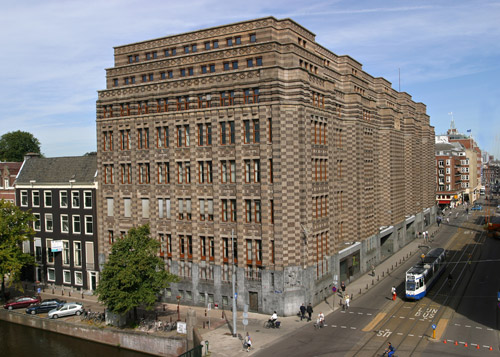 Another stop was the Archives
of the City of Amsterdam. The archivist at the information desk listened to my request for information about New Amstel and Fort Casimir, and with no hesitation showed me
showed me an entire archive of Delaware related material.
Another stop was the Archives
of the City of Amsterdam. The archivist at the information desk listened to my request for information about New Amstel and Fort Casimir, and with no hesitation showed me
showed me an entire archive of Delaware related material.
It was an archive of documents of Dr. Simon Hart, former Chief of the Archives of the City of Amsterdam. His work covers many areas and the highly organized inventory of his work appears to contain about 19,000 pages! He was active 1930-1981.
Hart wrote "The City-Colony of New Amstel on the Delaware" in 1965 and published it in the quarterly journal "Halve Maen" (the name of Hudson's ship, the Half Moon). The article included an assessment by New Amstel Director Jacob Alrichs that painted a much more dismal picture of the immigrants and the financial condition of the colony than I had seen, I have put online both the draft version (courtesy Amsterdam City Archive, Archive 883: Archief van Dr. S. Hart Inventory number 591) and the published version.
In the draft of the Halve Maen article, he quotes Alrichs as saying (p7) "The quality of the newly-arrived emigrants was none too good "Many that come hither are as poor as worms, and lazy to boot." Comparatively few of the new arrivals were capable of doing agricultural werk. The City Fathers then sent out pooroouse orphans to the colony; such children came in very useful and were all soon apprenticed, but those under fifteen and the weaklings among them could not be employed. The City colony did not prosper, harvest failure, heavy rains, sickness and the behaviour of the British all contributed to its decline. In 1658 the prevalent fevers had already caused the deaths of about one hundred persons, owing to which many families were left unsupported. In August 1659 there were 110 houses and some public buildings. The number of really good farmers was estimated as being three! For the rest a total of 137 artisans (most of whom did not know their jobs), 70 soldiers and 300 women and children, had come into the colony. With one thing, and another, the City was losing money. The debts which many colonists had contracted to the City Council were never paid.
Business models: Factory or trading post"York Factory
He previously published in 1961 "DE STADSKOLONIE NIEUWER-AMSTEL AAN DE DELAWARE RIVER IN NOORD-AMERIKA" in Amstelodamum, a journal about Amsterdam. In addition to the material covered later in the Halve Maen, he includes a description of the Plockhoy Mennonnite colony near Lewes, destroyed "to a naile" by the British in 1664. The draft (File 2.5.5.1.588) available at the archives appears to include an image of the council grant to Plockhoy as well as the resolution to create New Amstel. This link works on a Mac in Chrome (with Flash) but not Safari or Firefox, and with Microsoft Edge on a PC. The Archive has a list of other "Documents relating to the history of New Castle, Del. and the State of Delaware">
Image of the original Amsterdam City Council resolution to create the colony of Nieuwer Amstel, Mar. 3, 1656, and the 1856 Brodhead translation
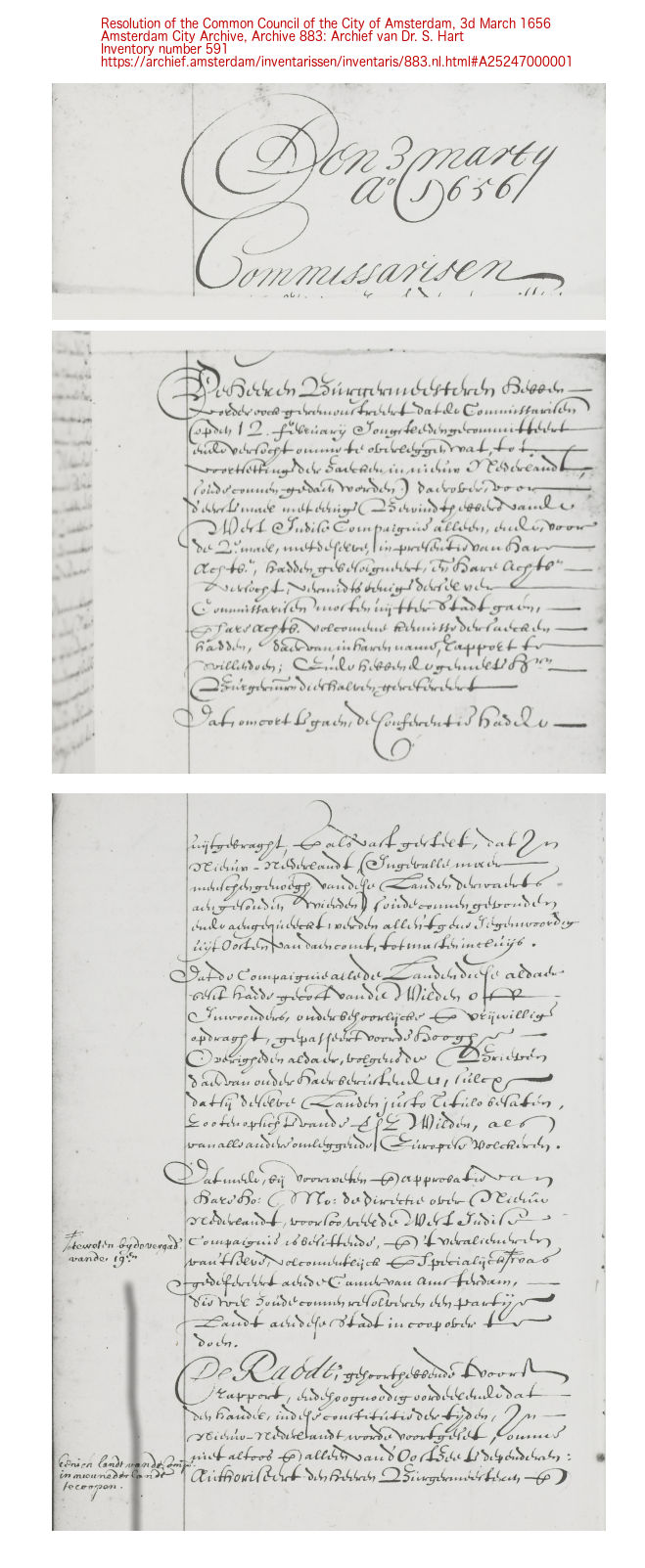
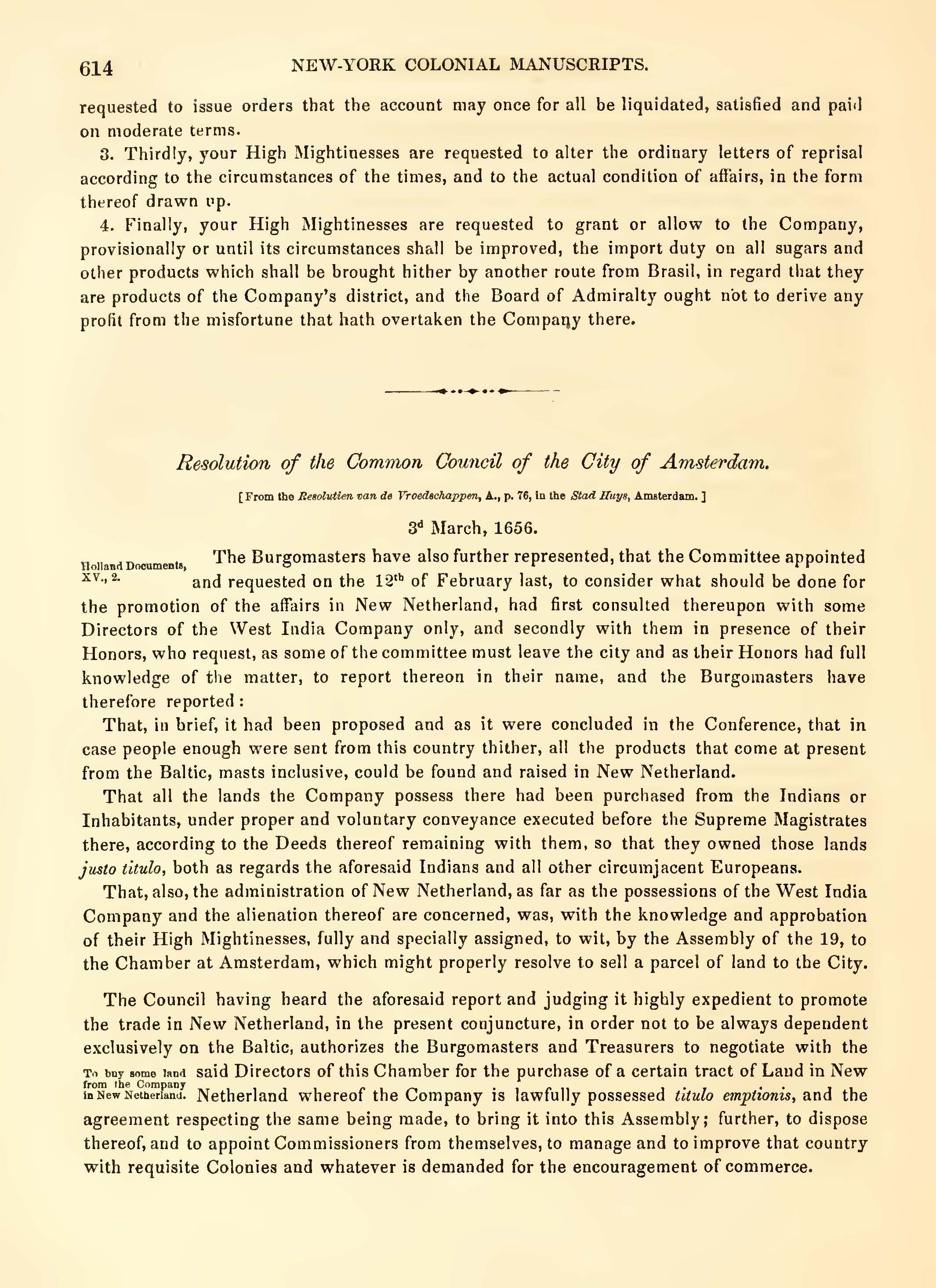
While it is a thrill to see images of an actual document, I must admit that aside from several dates and parts of a few words like Commissari..., I can't read it at all, much less translate it. It would be fun to try to read it with the help of a transcription of the Dutch.
Who was Ft. Casimir named after?
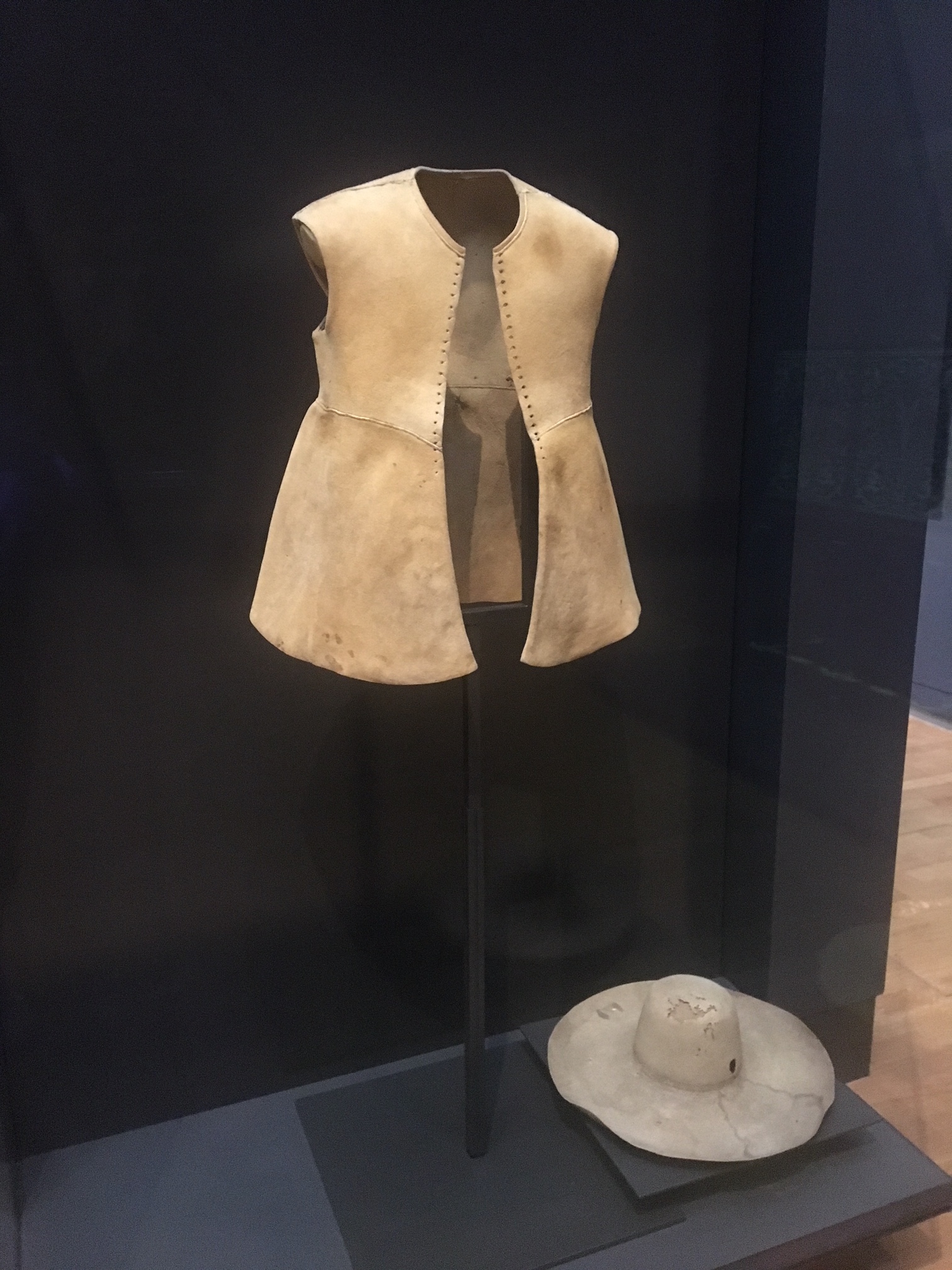 I was in the Rijksmuseum viewing the Golden Age paintings (some of which were relevant to the artifacts in the Old Dutch House
in New Castle). Just before closing I visited an area of miscellaneous stuff, and there in a case were the clothes complete with bullet holes from two members of the Casimir family that
had died in battle. The buff coat had been worn by
Henry Casimir (1628-1640) under his armor. The hat (also with a bullet hole) had been worn by his father Ernst (1573-1632) who also died in battle. Both had been "Stadholders" (~king) of Friesland,
the province where Stuyvesant (b 1610 ) grew up. So Ft. Casimir might be named for one of them. Or as Jaap Jacobs
pointed out on page 40 of his description of Dutch Colonial Fortifications, it could be named after Polish king John II Casimir Vasa, though
the Amsterdam directors wrote in 1652: "For what reason this fort is so named has not been revealed to us"
I was in the Rijksmuseum viewing the Golden Age paintings (some of which were relevant to the artifacts in the Old Dutch House
in New Castle). Just before closing I visited an area of miscellaneous stuff, and there in a case were the clothes complete with bullet holes from two members of the Casimir family that
had died in battle. The buff coat had been worn by
Henry Casimir (1628-1640) under his armor. The hat (also with a bullet hole) had been worn by his father Ernst (1573-1632) who also died in battle. Both had been "Stadholders" (~king) of Friesland,
the province where Stuyvesant (b 1610 ) grew up. So Ft. Casimir might be named for one of them. Or as Jaap Jacobs
pointed out on page 40 of his description of Dutch Colonial Fortifications, it could be named after Polish king John II Casimir Vasa, though
the Amsterdam directors wrote in 1652: "For what reason this fort is so named has not been revealed to us"
Business models of the WIC, Hudson's Bay Company and other Colonial organizations
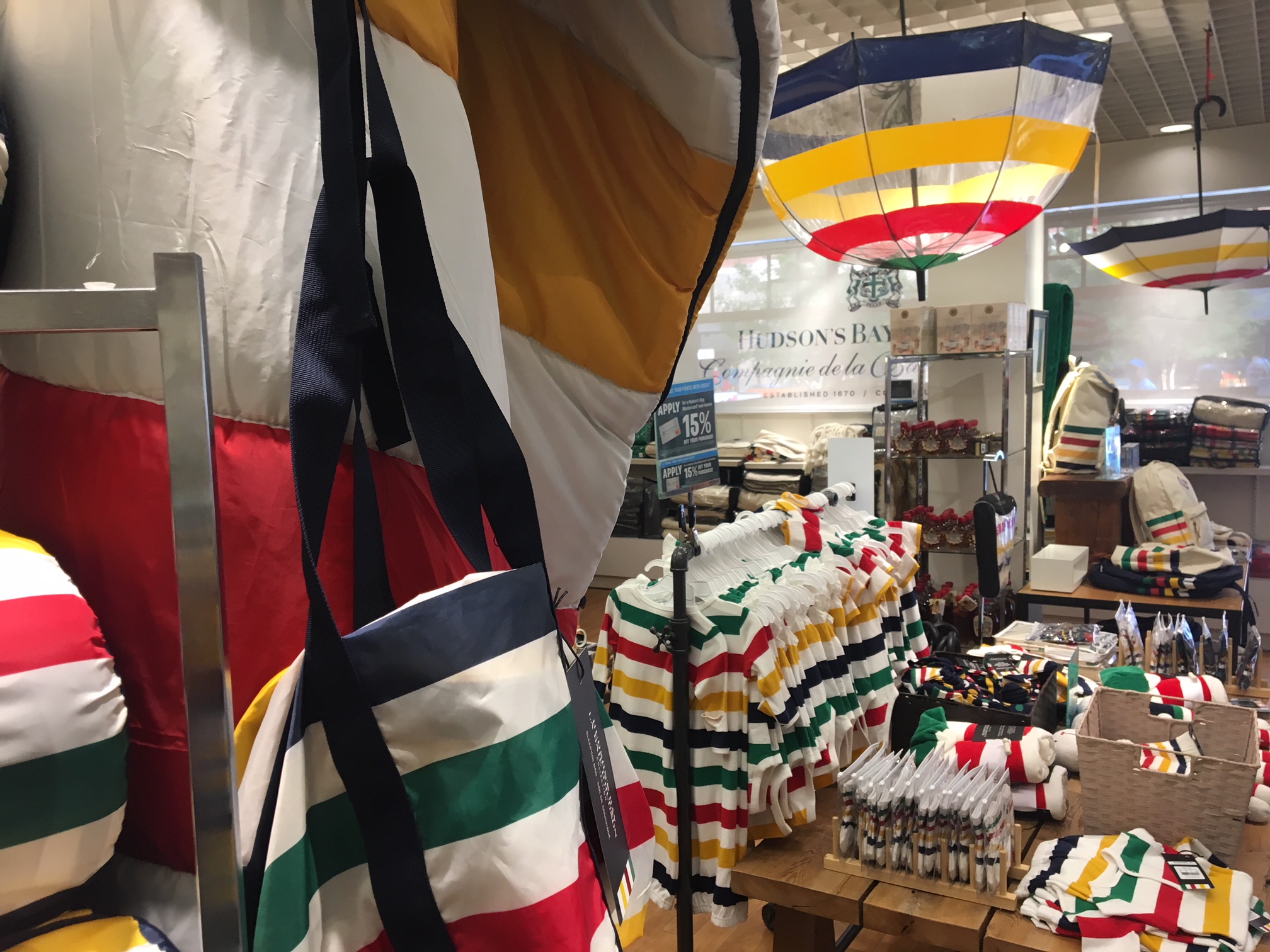
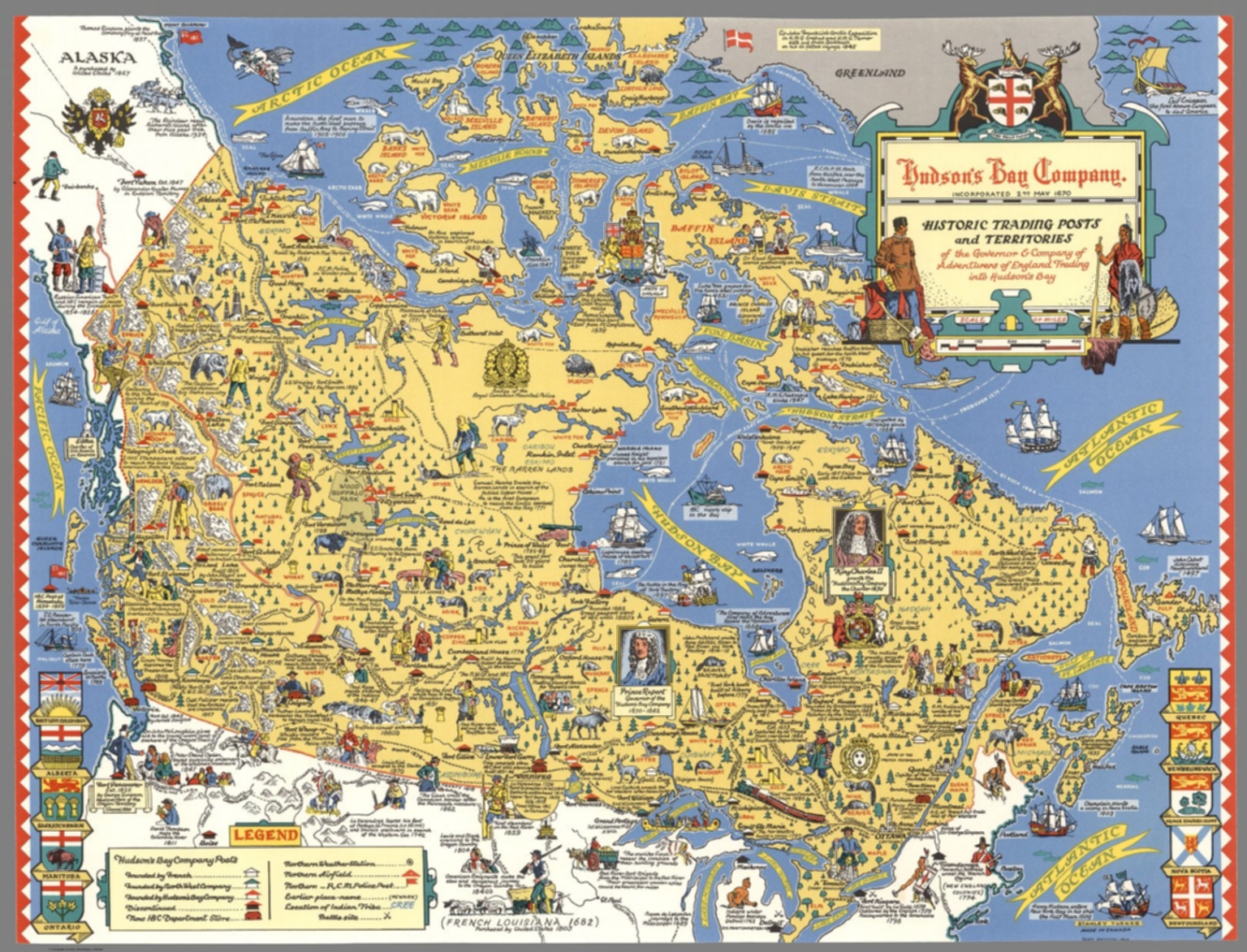
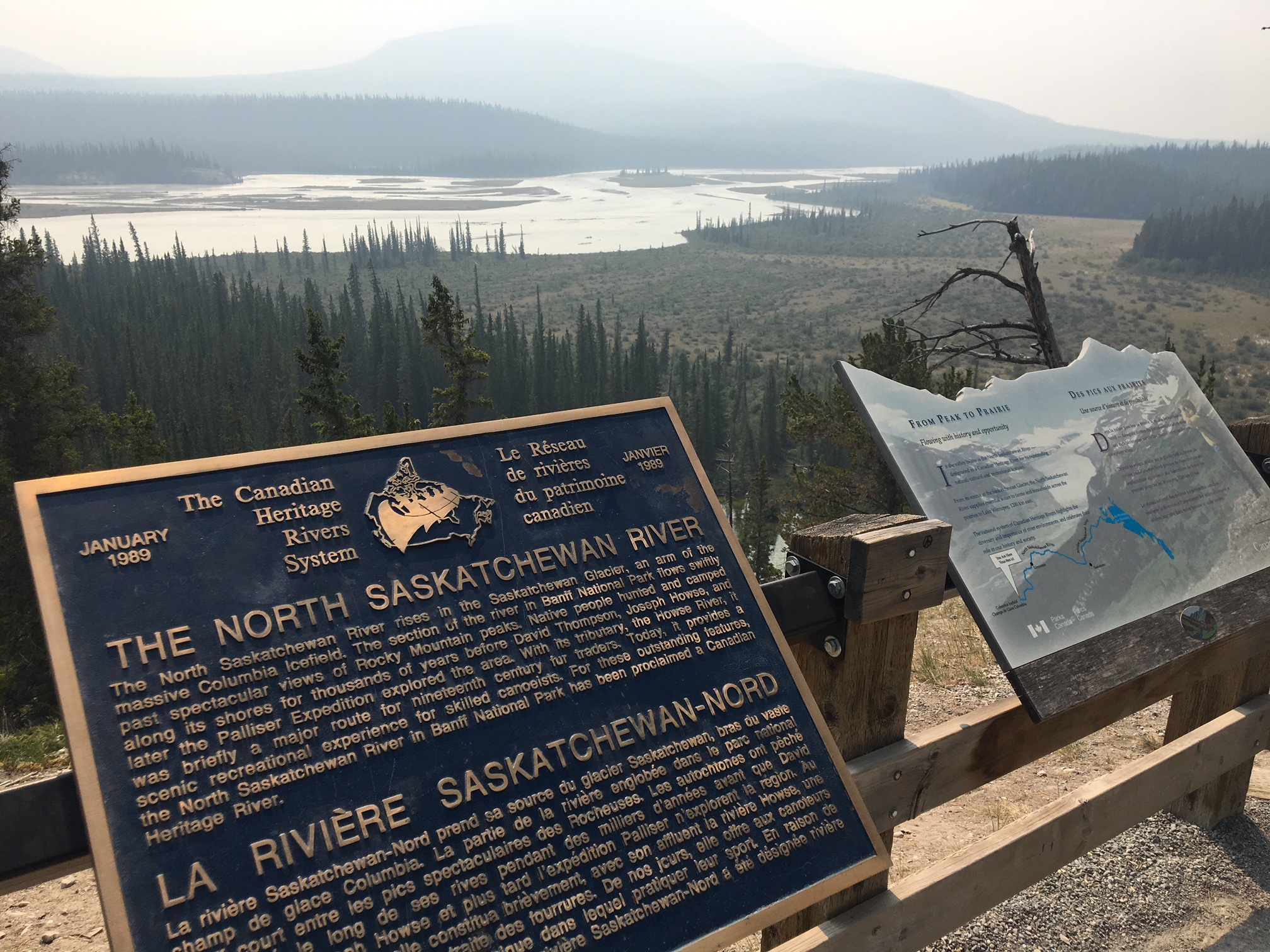
The book "Merchant Kings" described the difficulties the Hudson's Bay Company (HBC) had in continuing to supply beaver pelts to the customers in England. Like the WIC, traders depended on natives to trap the animals, and bring the skins in to them for trade. In the case of the WIC this meant from the Mohawk valley to Albany, in the case of HBC from western Canada to Hudson's bay. A few weeks ago I visited a HBC store in Banff, Canada where my wife tried on a Laura Ashley sweatshirt. No beavers or metal trade goods were on display. But a sign proudly proclaimed 'Established 1670." On the wall was a map of MANY trading posts in a huge area of Canada. Supposedly, only 400-500 employees covered this area, one or two per post. The difficulty in exploring, building forts the moving trade goods by canoe or back pack from the Pacific to Hudson's Bay can barely be imagined. The Saskatchewan and Columbia rivers were scouted by David Thompson for the HBC and North West companies and used for trade.
Unlike the WIC, the HBC is still operational, though it has long since stopped trading in furs. Although I'm not familiar with business theory, it seems to me that both the WIC and HBC have 'thin' organizations: a few mostly male employees and buildings at widely separated areas with little or no settlement around them. In contrast, English in Virginia, Massachussetts, and later in Pennsylvania and the French and Spanish in other areas had a much 'thicker' model with large numbers of families placed on the land. The many Americans settling in Oregon and Washington were major factors in the HBC losing the ability to control the area. The Swedish settlers do not match either model. Farms were built up and down the river, but with a small total population. Trade was never extensive, and there was at least one 5 year gap when no vessels bringing trade goods or taking away products came up the river.
UNDER CONSTRUCTION
Curacao, Bonaire, Aruba and St. Maaarten/St. Martin
salt, horses, financially unsuccessful, slavery museum, slavery image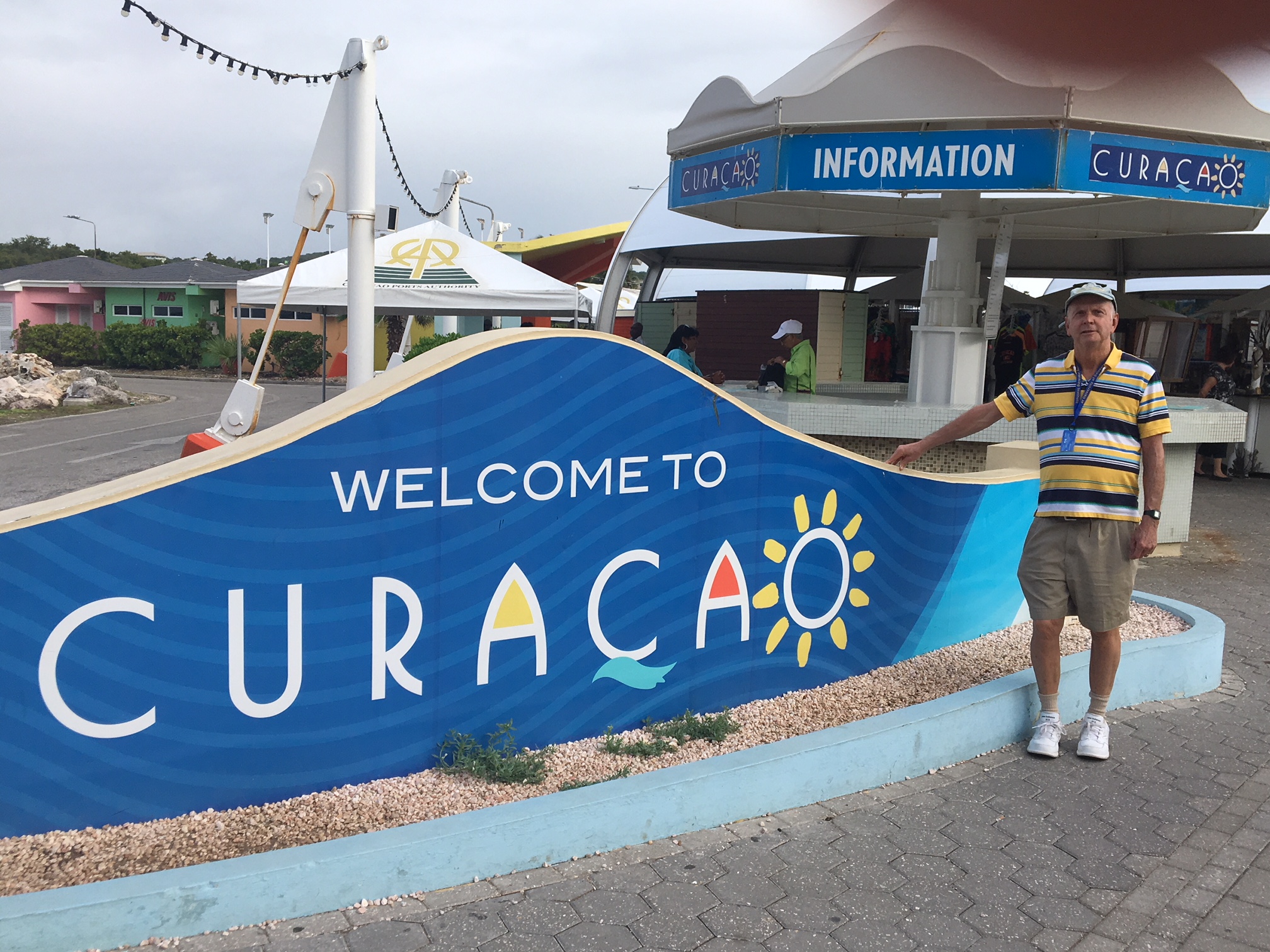
These islands now have great water for diving and snorkeling and good tourist accomodations. The beaches are an attraction, but to be honest, not as good as those along the New Jersey and Delaware coasts.
Syuyvesant was director general of the first three islands, It was while trying to recapture St. Maarten/St. Martin from the Spanish that he lost his leg, a sacrifice that may have helped him become director of New Netherland for the WIC.
What's relevant to New Castle history in Curacao are the Mikve Israel-Immanuel synagogue (the oldest continuously used synagogue in the western hemisphere) and the Kura Hulanda slavery museum.
The first Jewish community on Curacao began in 1651, coincidentally the same year that Ft. Casimir was founded. One wonders whether if Stuyvesant had been on the ground then in Curacao would he have allowed the settlement. In 1655, he refused the petition of a number of Jewish residents of New Amsterdam to trade on the South River.
The islands are perhaps almost as unlike how he knew them as old New Amsterdam is unlike modern Manhattan. In 16??, Curacao then as now was the most populated of the 'ABC islands'. The main products of Curacao ('Coracoa') and St. Maaarten was salt.
Jim Meek 'Sept. 1, 2018